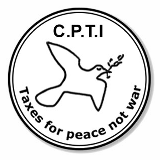Workshop Number 11
Led by Betsy Corner and Bob Bady
The workshop was about the stories of two IRS seizures of homes in Colrain, Massachusetts. Originally, the workshop was to be led by Randy Kehler and Betsy Corner, a couple whose home was auctioned by the IRS in July 1989. However, illness prevented Randy from coming. Bob Bady, whose home was also auctioned by the IRS in November 1989 (a much less publicized case than Randy and Betsy's), stepped in to lead this workshop with Betsy. He was very much in the center of the action regarding both houses.
Below is a brief chronology of the IRS seizures, and the responses of the war-tax-resistance community, followed by other observations.
Actions leading up to the seizures:
- Vietnam War: Randy spent time in federal prison for resisting the draft, and became a war tax resister.
- 1970: Bob became a war tax resister.
- Late 1970s: Betsy and Randy married; Betsy increasingly supported war tax resistance.
- 1983: a federal lien was placed on Bob's home (the IRS would collect the amount of the lien when Bob sold his home)
- 1980s: After being singled out by the IRS, presumably in part because of their visibility and public activism, their homes were targeted for collection by federal marshals.
The seizures:
- July 1989: Randy and Betsy's home was auctioned by the IRS. Their community was supportive - they made ‘bids’ of offers to do community service, to donate canned goods for the needy, and the like. Not one monetary bid was made. After this, the US government bought Randy and Betsy's house, and later auctioned it off again, this time to a family. Randy and Betsy did not leave their home even after the house was sold - they would not acquiesce to the IRS's attempts to collect war taxes from them. The family who purchased the home harbored strong feelings against Randy and Betsy living in the house, and against the fact that Randy had been a draft resister in the Vietnam War.
- November 1989: Bob Bady's house was auctioned. The IRS ensured that there would be a real bid from an individual this time. However, land trust issues complicated the sale, and the individual never took possession. Later, Bob and his partner split up. Each owned half the house, but some time after Bob moved away, his former partner settled with the individual to whom the house had been sold, and bought her out without his knowledge (summer 1996).
Vigils by war tax resisters:
- December 2, 1991: US government evicted Randy and Betsy.
- December 3, 1991 to early June 1993: Round-the-clock vigils, seven days a week, began.
Twenty different affinity groups from the Northeast, and various individuals from around the country organized by Bob kept the vigil going non-stop. Groups generally stayed a week at a time. Randy spent ten weeks in jail for refusing to leave the house while Betsy and their daughter lived elsewhere in the community to ensure that both parents were not in jail at the same time, out of respect for the needs of their daughter. At first, the resisters vigiled inside the house, but once the family who had bought the house moved in, they vigiled outside, and later from across the street. This was a time of tremendous community building within the war tax resister community.
New homes:
- December 1993: An out of court settlement between the land trust which owned the land under and around the house and the family who had purchased Randy and Betsy's home was reached.
- December 1994: Randy and Betsy moved into the new home they built with Betsy's mother on land trust land adjacent to their previous home.
- Currently: Randy and Betsy continue to live in Colrain with their daughter. Bob is living in Brattleboro, Vermont with his new partner and three-month-old child. They are very down-to-earth, ordinary people who have had some extraordinary tests during their life journeys. They continue to listen to and follow the dictates of the conscience, and take the consequences, both positive and negative, in stride.
Much publicity surrounded the seizure of Betsy and Randy's home. Bob's situation received much less media attention because it was a more complicated story to relate. For a period, it became normal fare for them to talk with major newscasters. The publicity helped neighbors within Colrain understand and accept the actions of Betsy, Randy and Bob. After Randy and Betsy appeared on the Phil Donahue show, one neighbor told them she'd never understood what they were doing until then. Others said they did not agree with what the Randy and Betsy were doing, but they respected them. Having things in the papers and on TV helped make it ‘real’ and legitimate for people.
I was inspired by the way both Betsy and Bob spoke of the ordeal of losing their homes. Again and again they emphasized the strength of the support - the community that built up because of the seizures. When they wondered why they were continuing to resist the demands of the IRS, they found renewed resolve from thinking of the alternative: paying for the killing they saw around the world, thinking of the widows, orphans, the maimed and the homeless. I saw in Betsy and Bob an inner strength that had been tested and refined through the ordeal. . Many lessons have been learned and many people near and far have been affected by both witnessing and participating in these actions. People continue to be influenced by the video “An Act of Conscience” that was filmed about The Corner / Kehler seizure (which was shown in the evenings at the conference). (See bibliography for more info about the video.)
Scribed by Sue Klassen
